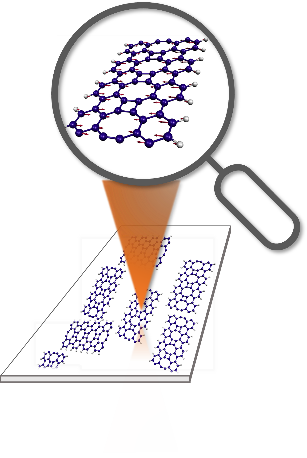Planar Carbon Lattices
RTG-2861-PCL
C4 - Optical/vibrational signatures of structural & electronic topology
Principal investigator: Prof. Dr. Janina Maultzsch, FAU Erlangen, [webpage]
On-surface synthesis, controlled edge termination, and chemical modification of PCLs provide new opportunities for manipulation of electronic states and design of novel carbon-based network architectures with non-trivial topology. Yet the resulting electronic, vibronic, and optical properties of such new PCLs must be comprehensively understood. A major challenge is to develop general spectroscopic signatures of structural and topological motifs of PCLs, such as specific edge structures, defects through non-hexagonal rings or heteroatoms, lattice symmetry, and substrate interaction. Here we will combine versatile optical spectroscopy methods, i.e., resonance Raman scattering and photoluminescence (PL), with local probing (tip-enhanced Raman scattering – TERS, SPM) and theoretical predictions.

Figure: Vibrational modes of a novel GNR.
We aim at a comprehensive physical understanding of edge-controlled graphene nanoribbons (GNRs), two-dimensional polymers (2DPs), and 2D graphenoid lattices. Raman spectroscopy is a most versatile tool to probe structure, symmetry, edge termination, potential defects, and vibronic properties non-destructively in various environmental conditions. For obtaining local information on a scale of ~20 nm, TERS and co-local AFM-Raman measurements will be applied in addition to confocal Raman scattering and PL.
Thesis topic: Vibrational signatures of edge topology in novel GNRs
We will develop a set of generalized vibrational signatures for edge topology (e.g., cove type), non-hexagonal rings, and hetero-atoms in GNRs in a combined experimental and theoretical approach. Based on DFT computations (supervision supported by Dr. Roland Gillen), we will predict the vibrational and electronic properties of novel GNR structures with topologically protected states in the electron band structure (Figure). These will be studied in Raman and PL experiments on GNRs prepared by Feng and Maier, both as ensemble measurements and on surfaces to correlate local probing on atomic scale with microscopic optical methods.
[2] F. Herziger, C. Tyborski, O. Ochedowski, M. Schleberger, J. Maultzsch, “Tunable quantum interference in bilayer graphene in double-resonant Raman scattering“, Carbon 2018, 133, 254-259.
[3] T. Dierke, D. Dasler, T. Nagel, F. Hauke, A. Hirsch, J. Maultzsch, “Spatial Control of Graphene Functionalization by Patterning a 2D Substrate: Implications for Graphene Based van-der-Waals Heterostructures”, ACS Applied Nano Materials 2022, 5, 4966.
